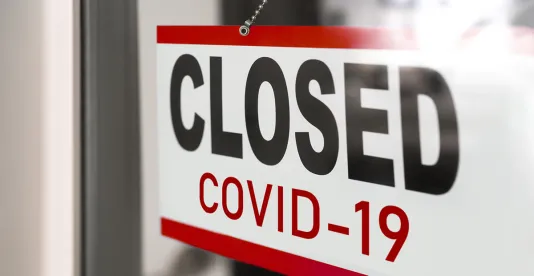The COVID-19 pandemic is challenging retailers in ways unique to the business. Not only do they have to ensure the health and safety of both customers and workers with effective strategies, they are struggling with managing the changing state and local business restrictions, pervasive staffing changes, and unanticipated supply chain shortages.
Many retailers have consulted with government agencies, health experts, and retail industry association groups on how to address unanticipated challenges to retail operations. Guidance from the U.S. Department of Health and Human Services’ Centers for Disease Control and Prevention (CDC) and the Occupational Safety and Health Administration (OSHA) confirms that retailers have a medium-level risk for exposure to COVID-19, as they have frequent and close contact with the general public. However, the guidance provided to date leaves many questions unanswered.
OSHA Guidance
To date, OSHA’s primary recommendation to retailers for managing potential COVID-19 exposures has been to install engineering controls where possible to minimize employee contact with the public. See OSHA’s Guidance on Preparing Workplaces for COVID-19.
In application, this means retailers should consider:
-
Installing clear plastic barriers, such as sneeze guards, between workers and customers; or
-
Implementing procedural mechanisms for workers to avoid face-to-face contact, such as through phone-based communication or online ordering.
OSHA also has recommended that retailers keep customers informed about COVID-19 symptoms and ask them to remain at home if they feel ill, as well as limit customer and public access to retail facilities to the extent possible.
Issues Not Addressed
OSHA’s guidance does not, however, address some of the health and safety challenges occurring at retail locations as an indirect result of the COVID-19 pandemic. These challenges include how to:
-
Provide and document effective health and safety training for rapidly changing workforces;
-
Ensure accurate recording of COVID-19 cases where there is objective evidence of work-relatedness (e.g., employees working closely together develop COVID-19 without an alternative explanation);
-
Minimize risks to workers posed by aggressive shopping (e.g., fights between customers over items and consumer stockpiling) and customer conflicts; and
-
Overcome the effects on worker safety performance and awareness caused by stress, anxiety, and sleep disturbances.
Retailers may further be challenged by high incidents of worker absenteeism, resulting in general discord, employees having responsibility for new or significantly changed tasks, and tasks being completed in a rushed or hurried manner.
What Retailers Can Do
Retailers should evaluate carefully how their operations are changing in light of the COVID-19 pandemic and determine whether additional health and safety measures are needed (e.g., protective barriers, changes in customer contact, or increased cleaning and sanitation procedures).
Retailers also should consider whether their health and safety program, and corresponding training, need to be modified in substance or in how it is conducted (e.g., online training vs. classroom setting), to address recent changes in operations and potential health and safety hazards the can occur as an indirect result of the COVID-19 pandemic.
Some considerations for retailers’ health and safety programs include:
-
Adopting procedures that allow for social distancing, such as minimizing workplace access points, creation of job rotations or staggered shifts to reduce workplace capacity, and reduced use of shared facilities;
-
Incorporating fit-for-work screening methods to identify high-risk workers before they enter the workplace and strategies for limiting potential exposures through face-to-face contact;
-
Implementing mechanisms for communicating effectively to employees and customers on evolving procedures and practices, as well as to respond to questions and concerns;
-
Providing facility-specific cleaning, disinfection, and sterilization procedures;
-
Identifying and implementing feasible engineering controls to protect employees and customers, such as installation of physical barriers, increased ventilation, and use of high-efficiency air filters; and
-
Making adjustments in operational and management procedures for HVAC equipment to ensure equipment is cleaned, maintained, and operated in a way that reduces exposure risks.
Special thanks to Dr. Shannon Magari, who contributed to this article.








 />i
/>i
